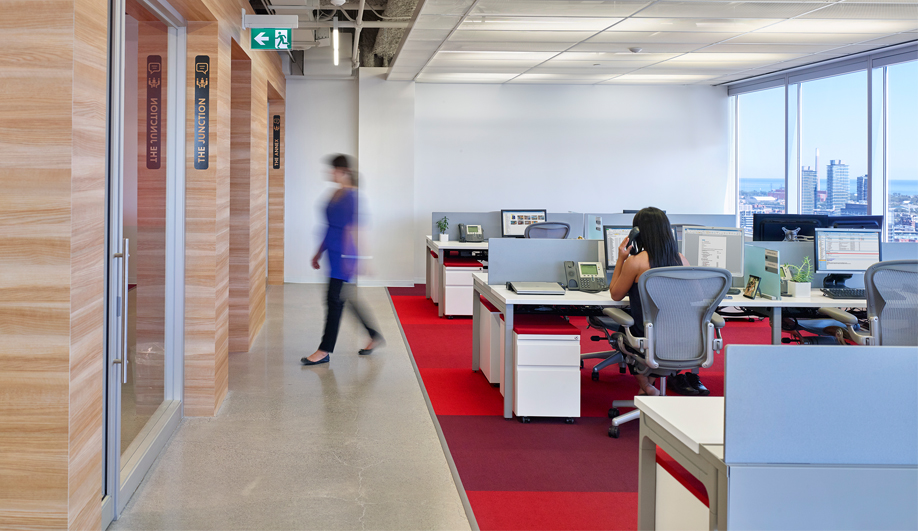
Ready to revisit your floor plan? We asked Heather Dubbeldam, principal at Toronto’s Dubbeldam Architecture + Design, for a few tips on reorganizing the office. After all, her firm has crafted inspired workspaces for the likes of Travelzoo (shown above and below), Slack, and more.
Here are five things to consider when reorganizing the office:
Unique Needs
There’s no one-size-fits-all template for piecing together the perfect floor plan. In any office, there will be trade-offs, so the first step is to understand your priorities. “Some companies want things to be more open and collaborative, with fewer barriers and walls,” explains Dubbeldam. “Others need separate offices, depending on how they work.”
Start by developing a list of practical needs, including the size and number of breakout spaces, meeting rooms, desks, and private offices, and how much space you’ll want to devote to reception or hosting events.
A word of warning: allow ample time for this process. Not everyone will agree on, for example, how many breakout spaces are needed, and managing feedback from everyone who’ll be working in a space – though important – is a time-consuming process. Even if you decide to turn everything else over to a professional designer, you’ll still need to provide them with this basic info.
Comfort
“If employees are comfortable and happy, they can be more efficient and more productive,” says Dubbeldam. “Today, the trend is towards what they’re calling a democracy of natural light.”
Daylight has a measurable effect on mood, circadian rhythms, and health. In addition, access to views of the world outside — especially greenery — has been shown to have a positive effect on concentration. Given these considerations, it’s no surprise that current best practice is to line up desks along the windows, and cluster common areas like meeting rooms and kitchens at the centre of the floor plan.
Limiting noise pollution is also critical to keeping people happy. There are multiple ways to attack this problem, such as spreading desks further apart or even relegating conversation to designated breakout areas. There is also a plethora of ways to introduce acoustic materials to a space, including rugs, draperies, wall panels and upholstered furnishings — and, of course, partitions (more on that here).
Collaboration
Ask any successful start-up: collaboration is key. And to encourage collaboration, you need to give your team chances to interact. That starts with the workspaces themselves. “You can buy partitions in all different heights,” says Dubbeldam, “but do you want the cubicle where you’re blocked in, you don’t have a view? Generally, people aren’t buying those anymore. They want them lower, so you can catch someone’s eye and talk to them, because there’s more collaboration in how people work now.”
Collaboration can also be encouraged with the floor plan itself. Keeping employees in a wide-open space can help with this, but this set-up needs to be complemented with breakout areas where people or teams can retreat when necessary. The larger the office, the more numerous and varied these can be: phone-booth rooms for making calls or completing work that demands a high level of concentration; casual spaces where two people can hold an impromptu conversation; and small meeting rooms for three or more people to talk or video conference.
All-hands spaces, whether a formal boardroom or an informal amphitheatre-style clearing where you can convene your entire staff at once, are also growing in popularity. “It’s all about getting everybody on board,” says Dubbeldam.
Consider, too, how employees will circulate. For example, separating departments might mean they’ll never interact. “Unplanned interactions are all about being productive and workflow. You’re passing your boss in the hall and they say, ‘Hey, did you look into that thing?’ or even ‘What are you working on right now?’” Dubbeldam explains. “But it’s also about the need of people to be social. Not to socialize – just to see them and get to know them by name. Some companies get so big, you don’t know anybody else. If you can facilitate these encounters, it’s healthier.”
Even when departments must be segregated for practical reasons, it’s still possible to use circulation to encourage this kind of interaction, by placing popular destinations like washrooms or printing stations in places that force people to move out of their core zone. And, as Dubbeldam points out, “The kitchen is always the heart. It’s not just a cliché – it’s literally a hub.”
Flexibility
Especially when space is limited, flexibility is an important way to squeeze the most out of your space. “You have to design for flexibility,” Dubbeldam says. “And it’s challenging. We’re still wired. Desks are put in place, and they’re usually left there – you can take them and move them around, but you can’t do it every day.”
Even if the workstations can’t be flexible, almost any office can include at least some multi-functional spaces. In selectively-used areas like the all-hands space or kitchen, a few simple gestures — like sliding partitions, or furniture that can be easily stacked and rearranged — allow them to play multiple roles.
Reception is another underused space that can easily double as a lounge and breakout zone— especially in casual, mid-sized offices. Furniture purpose-built for this kind of multi-functionality has boomed in recent years: look for pieces that can be wired for data and power, have wheels for easier transport, or are collapsible for storage.
Evolvability
Related to multi-functionality is the question of how well a space can adapt to your changing needs over time. “When you’re building things, there’s a limit to how flexible it actually can be,” Dubbeldam says.
Still, you can try to future-proof your space by keeping your furnishings modular. You’ll want to be able to swap out cabling and data ports, too, lest your entire workspace become obsolete the next time Apple changes their chargers. In this case, low-tech solutions are sometimes the best: the simplicity of a Velcro-seal panel will be much appreciated if you find yourself moving desks and reconfiguring your wiring often.
On a macro scale, in an industry like software development that sees rapid expansion and contraction, you can explore how different departments can fit into the larger whole. Dubbeldam describes a tech incubator she designed that took the idea to extremes: the floor plan included spaces for two-, four-, eight- and 24-person teams, with shared amenities like a kitchen and reception. As teams grew, they simply moved up the ladder into the next larger space. By the time a team had outgrown the 24-person space, it was time for them to move to a separate office.
Whether you’re relocating entire departments or simply turning the kitchen into a breakout space, a few tweaks can result in a modern office that can embrace the dynamism of mobility like never before.

